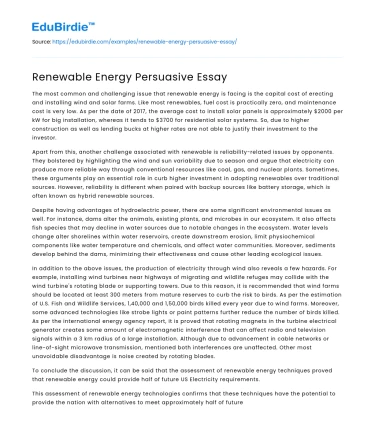The most common and challenging issue that renewable energy is facing is the capital cost of erecting and installing wind and solar farms. Like most renewables, fuel cost is practically zero, and maintenance cost is very low. As per the date of 2017, the average cost to install solar panels is approximately $2000 per kW for big installation, whereas it tends to $3700 for residential solar systems. So, due to higher construction as well as lending bucks at higher rates are not able to justify their investment to the investor.
Apart from this, another challenge associated with renewable is reliability-related issues by opponents. They bolstered by highlighting the wind and sun variability due to season and argue that electricity can produce more reliable way through conventional resources like coal, gas, and nuclear plants. Sometimes, these arguments play an essential role in curb higher investment in adopting renewables over traditional sources. However, reliability is different when paired with backup sources like battery storage, which is often known as hybrid renewable sources.
Save your time!
We can take care of your essay
- Proper editing and formatting
- Free revision, title page, and bibliography
- Flexible prices and money-back guarantee
Despite having advantages of hydroelectric power, there are some significant environmental issues as well. For instance, dams alter the animals, existing plants, and microbes in our ecosystem. It also affects fish species that may decline in water sources due to notable changes in the ecosystem. Water levels change alter shorelines within water reservoirs, create downstream erosion, limit physiochemical components like water temperature and chemicals, and affect water communities. Moreover, sediments develop behind the dams, minimizing their effectiveness and cause other leading ecological issues.
In addition to the above issues, the production of electricity through wind also reveals a few hazards. For example, installing wind turbines near highways of migrating and wildlife refuges may collide with the wind turbine's rotating blade or supporting towers. Due to this reason, it is recommended that wind farms should be located at least 300 meters from mature reserves to curb the risk to birds. As per the estimation of U.S. Fish and Wildlife Services, 1,40,000 and 1,50,000 birds killed every year due to wind farms. Moreover, some advanced technologies like strobe lights or paint patterns further reduce the number of birds killed. As per the international energy agency report, it is proved that rotating magnets in the turbine electrical generator creates some amount of electromagnetic interference that can affect radio and television signals within a 3 km radius of a large installation. Although due to advancement in cable networks or line-of-sight microwave transmission, mentioned both interferences are unaffected. Other most unavoidable disadvantage is noise created by rotating blades.
To conclude the discussion, it can be said that the assessment of renewable energy techniques proved that renewable energy could provide half of future US Electricity requirements.
This assessment of renewable energy technologies confirms that these techniques have the potential to provide the nation with alternatives to meet approximately half of future US energy needs. To develop this potential, the United States would have to commit to the development and implementation of non–fossil fuel technologies and energy conservation.






 Stuck on your essay?
Stuck on your essay?

